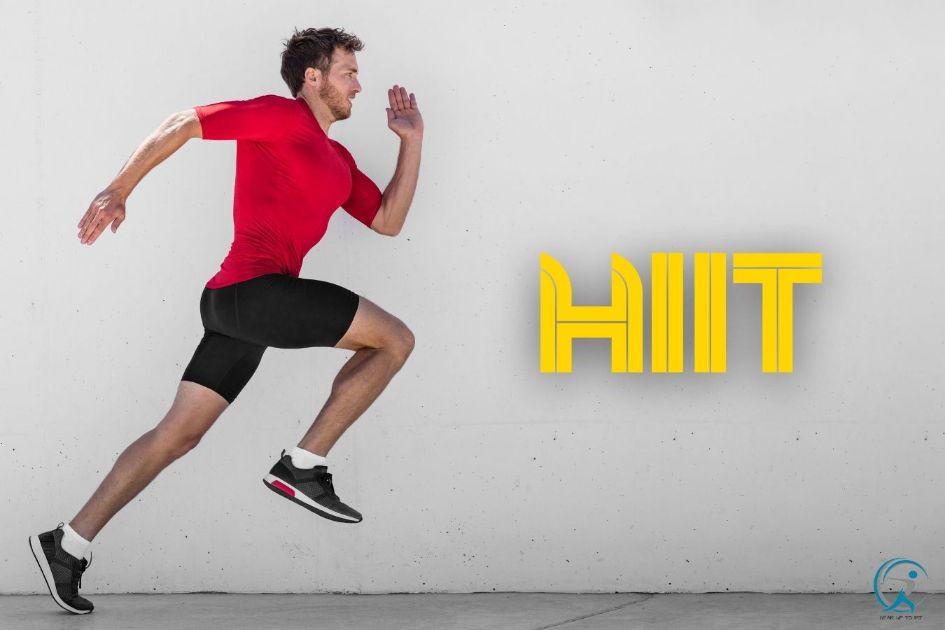Key Takeaways
- HIIT burns up to 30% more calories than traditional exercise, with studies confirming its superior efficiency
- Your metabolism stays elevated for up to 24 hours after HIIT through excess post-exercise oxygen consumption (EPOC)
- Just 20 minutes of HIIT three times weekly creates significant improvements in cardiovascular health
- HIIT preserves muscle while burning fat, unlike many forms of traditional cardio
- Results appear quickly—most people see noticeable changes within 4-6 weeks
- HIIT is highly adaptable for all fitness levels, from beginners to elite athletes
You will learn exactly how HIIT transforms your body. We cover its proven impact on heart health, insulin sensitivity, and muscle preservation. Discover how just 20 minutes, three times a week, can create significant change. Get ready for an efficient, evidence-based path to a healthier you.
Forget hours on the treadmill. HIIT delivers superior results in a fraction of the time. According to 2026 research, it can burn up to 30% more calories than traditional steady-state cardio. Your body enters a state of excess post-exercise oxygen consumption (EPOC). This powerful “afterburn” effect elevates your metabolism for hours.
High-Intensity Interval Training (HIIT) improves your health by dramatically boosting cardiovascular fitness, accelerating fat loss, and elevating your metabolism for up to 24 hours post-workout. This science-backed method alternates short, intense bursts of effort with brief recovery periods. It creates a powerful metabolic effect that continues working long after you finish.
5-Minute HIIT Workouts Anyone Can Do

Beginner 5-Minute HIIT Workout:
- 30 seconds: March in place
- 30 seconds: Rest
- 30 seconds: Modified push-ups (on knees)
- 30 seconds: Rest
- 30 seconds: Air squats
- 30 seconds: Rest
- 30 seconds: Shoulder taps in plank position
- 30 seconds: Rest
- 30 seconds: Jumping jacks
- 30 seconds: Rest
Advanced 5-Minute HIIT Protocol:
- 40 seconds: Burpees
- 20 seconds: Rest
- 40 seconds: Mountain climbers
- 20 seconds: Rest
- 40 seconds: Jump squats
- 20 seconds: Rest
- 40 seconds: Push-ups
- 20 seconds: Rest
- 40 seconds: High knees running in place
- 20 seconds: Rest
The 15-Minute Sweet Spot: Perfect HIIT Workouts for 2026
The 15-minute mark hits the perfect balance between effectiveness and time efficiency. These workouts deliver maximum results for minimal time investment:
Bodyweight 15-Minute HIIT:
- Warm up: 2 minutes light jogging in place
- 45 seconds: Burpees
- 15 seconds: Rest
- 45 seconds: Jump squats
- 15 seconds: Rest
- 45 seconds: Mountain climbers
- 15 seconds: Rest
- 45 seconds: Push-ups
- 15 seconds: Rest
- 45 seconds: Jumping lunges
- 15 seconds: Rest
- Repeat for 3 total rounds
- Cool down: 1 minute walking in place
Equipment-Based 15-Minute HIIT:
- Warm up: 2 minutes jumping jacks
- 40 seconds: Kettlebell swings
- 20 seconds: Rest
- 40 seconds: Dumbbell push press
- 20 seconds: Rest
- 40 seconds: Rower sprints (or jump rope)
- 20 seconds: Rest
- 40 seconds: Dumbbell walking lunges
- 20 seconds: Rest
- 40 seconds: Battle rope slams (or mountain climbers)
- 20 seconds: Rest
- Repeat for 2 total rounds
- Cool down: 1 minute gentle stretching
How HIIT Transforms Your Metabolism

HIIT creates a metabolic effect unlike any other form of exercise. Here’s exactly what happens:
- During the workout: You reach 80-95% of your maximum heart rate during intense intervals, creating an oxygen deficit your body must repay afterward
- Immediately after: Your body enters EPOC (excess post-exercise oxygen consumption), burning calories at an elevated rate while restoring normal oxygen levels
- Hours later: Your metabolism remains elevated for up to 24 hours as your body repairs muscle tissue and replenishes energy stores
- Long-term adaptation: Regular HIIT increases your mitochondrial density by up to 35%, permanently enhancing your body’s ability to burn fat
This powerful metabolic impact explains why HIIT is so effective for fat burning. According to 2026 research, HIIT can produce a 9-fold greater reduction in body fat than steady-state cardio, while also boosting your metabolic rate for hours post-workout.
HIIT for Beginners: Starting Without Injury
If you’re new to HIIT, follow these steps to begin safely:
- Start with a modified 1:2 work-to-rest ratio (30 seconds work, 60 seconds rest)
- Choose lower-impact exercises initially to master proper form and prevent strain:
- Marching in place instead of jumping jacks
- Step-backs instead of burpees
- Bodyweight squats instead of jump squats
- Begin with just 10 minutes total (including warm-up and cool-down)
- Limit HIIT to 2 sessions weekly with at least 48 hours between
- Use the Talk Test to Gauge Intensity. You must be breathless. If you can speak full sentences, you’re at 60% effort or less. Push harder. Your work intervals should hit 85-95% of your max heart rate. Use a Polar H10 chest strap or Apple Watch to track it.
- Progress gradually by first increasing workout duration, then reducing rest periods, and finally increasing exercise intensity
Remember: alternatives to HIIT like swimming or cycling can be better starting points for those with joint issues or who are significantly overweight.
Weekly HIIT Schedule Template

This balanced weekly schedule integrates HIIT with other forms of exercise for maximum results:Monday: 20-minute HIIT workout (full body)
- Focus: Cardio and strength combined
- Example: Circuit of burpees, kettlebell swings, mountain climbers, push-ups, and jumping lunges
Tuesday: 45-minute strength training + 10-minute low-intensity cardio
- Focus: Building muscle to support metabolism
- Example: Upper body resistance exercises plus easy walking
Wednesday: Active recovery
- Focus: Promoting blood flow without stress
- Example: 30-minute walk, light yoga, or swimming
Thursday: 15-minute HIIT workout (lower body focus)
- Focus: Targeted leg and glute power
- Example: Jump squats, lunges, box jumps, and glute bridges
Friday: 45-minute strength training + 10-minute low-intensity cardio
- Focus: Core and upper body strength
- Example: Resistance training for arms, back, and abdominals
Saturday: 20-minute HIIT workout or recreation activity
- Focus: Fun, high-energy movement
- Example: HIIT jump rope workout or sports play
Sunday: Complete rest or gentle stretching
- Focus: Recovery and preparation for the week ahead
- Example: Foam rolling, stretching, or meditation
Always allow adequate rest between HIIT workouts – at least 48 hours for the same muscle groups.
The Simple HIIT Equipment Starter Kit
You don’t need an elaborate home gym for effective HIIT. Start with these basics:
- Jump rope ($10-20): Perfect for warm-ups and high-intensity intervals
- Resistance bands ($15-30): Versatile for adding resistance to bodyweight movements
- Timer app (Free): Essential for precise interval timing
- Exercise mat ($20-40): Protects joints during floor exercises
- Water bottle ($10-15): Staying hydrated is crucial during HIIT
As you progress, consider adding:
- Kettlebell (one medium weight)
- Adjustable dumbbells
- Plyo box or sturdy bench
Nutrition Strategies for Maximum HIIT Results

What you eat significantly impacts your HIIT performance and recovery:Before HIIT (30-60 minutes prior):
- 15-30g easily digestible carbs
- Examples: banana, small fruit smoothie, rice cake with honey
- Hydrate with 12-16oz water
During HIIT:
- Sip water as needed (about 4-8oz)
- No need for calories during workouts under 30 minutes
After HIIT (within 30 minutes):
- Protein + carbs in 1:3 ratio (15-25g protein, 45-75g carbs)
- Examples: protein shake with fruit, chicken with sweet potato, Greek yogurt with berries
- Rehydrate with 16-24oz water or electrolyte drink
Daily nutrition for HIIT performance:
- Protein: 1.6-2.2g per kg bodyweight
- Carbs: 3-5g per kg bodyweight from quality sources
- Fats: 0.8-1.2g per kg bodyweight from healthy sources
- Hydration: Minimum 3 liters water daily
Troubleshooting Common HIIT Challenges
Problem: “I get too out of breath during intervals”
- Solution: Start with a 1:3 work-to-rest ratio (e.g., 20 seconds work, 60 seconds rest)
- Gradually reduce rest periods as fitness improves
- Focus on deep breathing during recovery periods
Problem: “My legs feel like jelly after just a few intervals”
- Solution: Alternate upper and lower body exercises
- Example sequence: burpees → push-ups → squats → shoulder taps → lunges
- Include more recovery days initially
Problem: “I’m not seeing fat loss results”
- Solution: Track calories – HIIT increases hunger, which can lead to overeating
- Ensure protein intake is adequate (helps with satiety)
- Add 1-2 low-intensity steady-state sessions weekly to increase total calorie burn
Problem: “I keep getting minor injuries”
- Solution: Always include a proper 5-minute warm-up
- Start with low-impact HIIT if you’re a beginner
- Focus on form rather than speed during exercises
Problem: “I get bored with the same routine”
- Solution: Try different HIIT formats (Tabata, EMOM, ladders)
- Use apps with guided HIIT workouts for variety
- Incorporate equipment like kettlebells, battle ropes, or medicine balls
Tracking HIIT Progress: Beyond the Scale
Measure your HIIT success using these metrics instead of just weight:
- Track Your Resting Heart Rate (RHR) for Proof. A 2018 study in the *Journal of Sports Sciences* found HIIT can lower RHR by 5-10 BPM in 8 weeks. Measure it for 7 days upon waking, before coffee. Use a WHOOP strap or Garmin Forerunner 965. A downward trend of 2+ BPM weekly confirms your VO2 max is improving.
- Recovery time: How quickly your heart rate drops after intense intervals
- Count heartbeats for 15 seconds immediately after an interval
- Count again after 60 seconds of rest
- The difference should increase as fitness improves
- Work capacity: How much you can accomplish in a set time
- Count total reps of an exercise in 30 seconds
- Retest monthly using the same exercise
- Progress = more reps in the same timeframe
- Body measurements: More reliable than scale weight
- Measure waist, hips, chest, arms, and thighs
- Record measurements every 2-4 weeks
- Take progress photos from front, side, and back
HIIT Results Timeline: What to Expect
Weeks 1-2:
- Improved energy and mood after workouts
- Slight increase in hunger and thirst
- Possible muscle soreness (normal adaptation)
- Workouts feel challenging but becoming more manageable
Weeks 3-4:
- Noticeable improvements in recovery between intervals
- Ability to push harder during work periods
- Enhanced mental clarity and focus
- Possible plateau in perceived exertion as fitness improves
Weeks 5-8:
- Visible changes in muscle tone and definition
- Measurable reductions in body measurements
- Significant improvements in workout performance
- Daily activities feel easier (climbing stairs, carrying groceries)
Weeks 9-12:
- Substantial changes in body composition
- Resting heart rate notably lower than starting point
- Ability to perform advanced HIIT variations
- Metabolic health markers improving (if tested)
Remember that consistency is key for seeing HIIT results – two to three quality sessions weekly will produce better outcomes than sporadic, excessive training.
Who Should Modify or Avoid HIIT?
While HIIT is highly adaptable, these groups should take special precautions:
Should consult a healthcare provider first:
- People with heart conditions or uncontrolled hypertension
- Those with untreated thyroid disorders
- Individuals with recent injuries or chronic joint pain
- Pregnant women or those recently postpartum
- Anyone with respiratory conditions like severe asthma
- Those with a history of exercise-induced dizziness
Should use modified approaches:
- Beginners over 50 (specific guidelines here)
- People significantly overweight (focus on low-impact options)
- Those with mild joint issues (water-based HIIT can be ideal)
- Anyone returning from illness or prolonged inactivity
The Ultimate 30-Day HIIT Challenge
Follow this progressive plan to transform your fitness in just one month:
Week 1: Foundation
- Monday: 10-minute beginner HIIT (30s work/30s rest)
- Wednesday: 12-minute beginner HIIT (30s work/30s rest)
- Friday: 15-minute beginner HIIT (30s work/30s rest)
- Focus: Learning proper form, building baseline conditioning
Week 2: Building
- Monday: 15-minute intermediate HIIT (40s work/20s rest)
- Wednesday: 15-minute intermediate HIIT with new exercises
- Friday: 20-minute intermediate HIIT (40s work/20s rest)
- Focus: Increasing work periods, decreasing rest
Week 3: Intensifying
- Monday: 20-minute advanced HIIT (45s work/15s rest)
- Wednesday: 15-minute Tabata-style HIIT (20s max effort/10s rest)
- Friday: 25-minute advanced HIIT (45s work/15s rest)
- Focus: Maximizing intensity during work periods
Week 4: Peaking
- Monday: 25-minute mixed-interval HIIT (alternating 20s, 40s, 60s work periods)
- Wednesday: 20-minute EMOM (Every Minute On the Minute) HIIT
- Friday: 30-minute advanced HIIT challenge
- Saturday: Active recovery + measurements/progress assessment
- Focus: Combining different HIIT protocols for maximum results
Track your progress throughout with a simple workout journal or fitness app.
Beyond Weight Loss: Mental and Health Benefits of HIIT
HIIT’s benefits extend far beyond just fat loss:
Mental Health Improvements:
- Reduces symptoms of depression by up to 26% in some studies
- Releases brain-derived neurotrophic factor (BDNF), supporting brain health
- Enhances focus and attention for up to 2 hours post-workout
- Builds mental toughness that transfers to other life challenges
- Provides a powerful outlet for stress and anxiety
HIIT is particularly effective for mental health because the intensity requires full presence, creating a form of moving meditation that breaks negative thought patterns.
Health Marker Improvements:
- Reduces blood pressure more effectively than moderate exercise
- Improves insulin sensitivity by up to 35%
- Increases HDL (good) cholesterol while lowering LDL and triglycerides
- Enhances heart function and blood vessel elasticity
- Reduces inflammatory markers linked to chronic disease
Many of these benefits appear even in the absence of significant weight loss, making HIIT valuable for people of all body compositions.
References:
- https://www.today.com/health/diet-fitness/hiit-benefits-rcna122954
- https://www.ewmotiontherapy.com/blog/high-intensity-interval-training-benefits
- https://www.puregym.com/blog/benefits-of-hiit-training-and-workouts/
- https://www.businessinsider.com/guides/health/fitness/benefits-of-hiit
- https://www.circlehealthgroup.co.uk/health-matters/exercise-and-fitness/10-benefits-of-hiit
- https://www.everydayhealth.com/fitness/potential-health-benefits-of-hiit/
- https://runrepeat.com/benefits-of-hiit
- https://www.healthline.com/nutrition/benefits-of-hiit
- https://pmc.ncbi.nlm.nih.gov/articles/PMC6763680/
- https://www.shape.com/fitness/workouts/8-benefits-high-intensity-interval-training-hiit
- https://www.researchgate.net/publication/338045865_The_benefits_and_physiological_changes_of_high_intensity_interval_training
- https://www.verywellhealth.com/benefits-of-hiit-8659170
- https://nutritionsource.hsph.harvard.edu/high-intensity-interval-training/
- https://pmc.ncbi.nlm.nih.gov/articles/PMC8294064/
- https://www.health.harvard.edu/exercise-and-fitness/cognitive-benefits-from-high-intensity-interval-training-may-last-for-years
- https://health.ucdavis.edu/blog/cultivating-health/high-intensity-workouts-can-help-you-get-fit-fast-but-preparation-is-key/2026/09
- https://www.nytimes.com/2026/11/10/well/move/hiit-high-intensity-interval-training.html
Frequently Asked Questions
How many calories does HIIT burn compared to regular cardio?
HIIT can burn up to 30% more calories than traditional steady-state cardio. This superior calorie burn is due to the intense exertion and the metabolic “afterburn” effect (EPOC), where your body continues to consume oxygen and burn calories at an elevated rate for up to 24 hours after the workout.
How long does it take to see results from HIIT?
Most people can see noticeable improvements in fitness, body composition, and energy levels within 4 to 6 weeks of consistent training. Performing HIIT workouts just three times a week for 15-20 minutes is often enough to create significant cardiovascular and metabolic changes.
Is HIIT suitable for beginners or people over 50?
Yes, HIIT is highly adaptable for all fitness levels. Beginners can start with low-impact, modified movements and longer rest periods. The principle of alternating high-intensity effort with recovery can be scaled to any starting point, making it a safe and effective option for most adults.
Can I do an effective HIIT workout in just 5 minutes?
Absolutely. A well-structured 5-minute HIIT session, like alternating 30-40 seconds of intense exercise (e.g., burpees, squats) with short rest periods, can elevate your heart rate and kickstart your metabolism. While shorter, these micro-workouts are effective for maintaining fitness on extremely busy days.
Does HIIT help with fat loss without losing muscle?
Yes, one of HIIT’s key advantages is its ability to promote fat burning while preserving lean muscle mass. Unlike long-duration steady-state cardio, which can sometimes lead to muscle breakdown, the intense, short bursts in HIIT signal your body to retain muscle while targeting fat stores for energy.
What is the EPOC effect in HIIT?
EPOC (Excess Post-Exercise Oxygen Consumption), often called the “afterburn” effect, is the state where your body continues to burn extra calories after a HIIT workout. It occurs because your metabolism remains elevated as your body works to restore oxygen levels, repair muscles, and return to its resting state.
Do I need any special equipment for a HIIT workout?
No special equipment is necessary. Many highly effective HIIT workouts, like the 5-minute and 15-minute routines mentioned, use only bodyweight exercises such as squats, push-ups, and jumping jacks. This makes HIIT accessible and easy to do at home, in a park, or while traveling.
Conclusion
HIIT stands as a revolutionary fitness paradigm for 2026, proving that maximum health benefits—from superior calorie burn and a 24-hour metabolic boost to enhanced cardiovascular function and muscle preservation—do not require endless hours at the gym. The science is clear: short, intense, and strategic effort delivers profound, rapid results.
Your next step is to integrate this efficiency into your life. Start with the adaptable 5-minute beginner workout this week, committing to just three sessions. Use a simple timer app to track your 30-second intervals, and focus on your personal best effort during each burst. Consistency with these brief sessions will build the foundation for greater intensity and duration.
The most powerful fitness transformation begins with a single, intense minute. Your 20-minute-a-week journey to a healthier, more energized you starts now. What will you accomplish with all the time and vitality you gain?
Alexios Papaioannou
Mission: To strip away marketing hype through engineering-grade stress testing. Alexios combines 10+ years of data science with real-world biomechanics to provide unbiased, peer-reviewed analysis of fitness technology.
